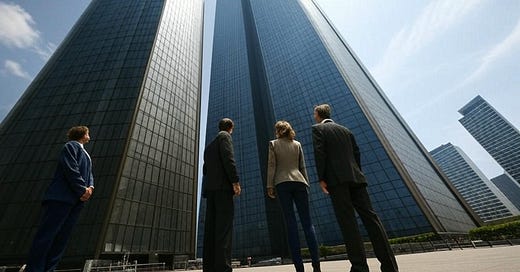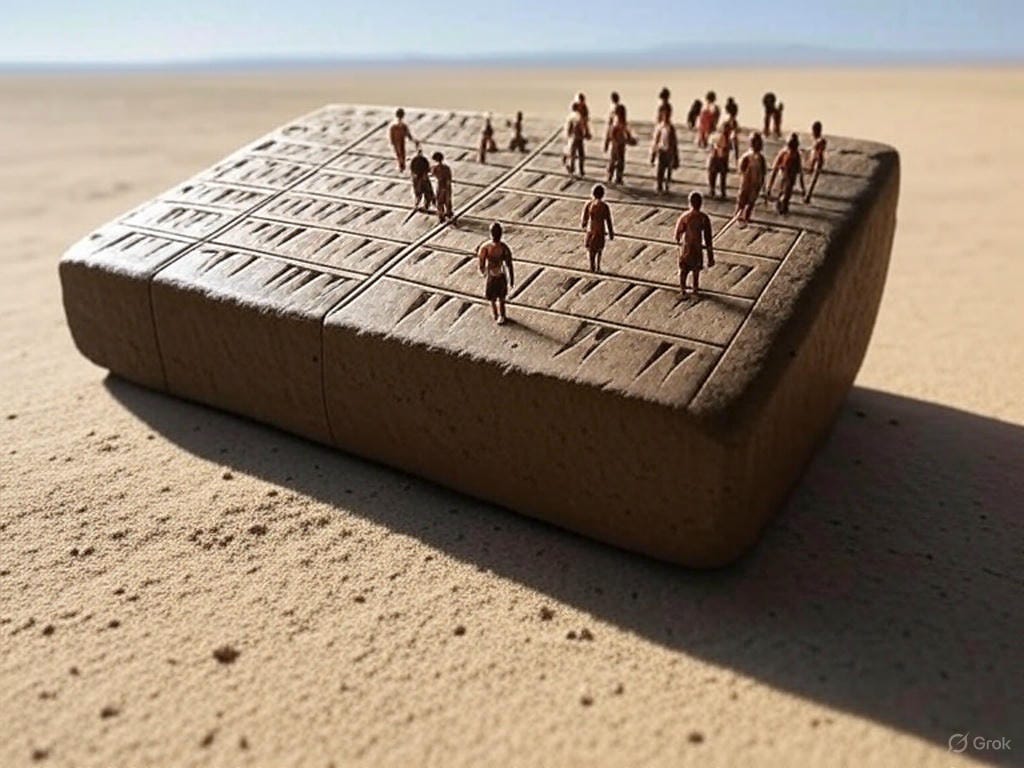TecC 17 - A Union of Minds: More than Meets the Eye
When Two and Two Make Five: Building Something Bigger and Better Together
A core objective of mine in this series is the exploration of how the mind works, how creativity happens, and how this leads to innovation and progress. That is indeed why I derive the name of the series from the Ancient Greek tekhne.1 In the previous episode we covered one of the most important technological breakthroughs in this context: the invention of writing. Let’s now explore how this supercharged human innovation and organization.
I’ve previously mentioned how it’s easy for us to take writing for granted, because it’s a ubiquitous part of modern life. I’ve equally also emphasized that certain pre-literate peoples had developed very sophisticated cultures despite the lack of writing, using solely mental devices such as memorization. This is in some sense a testament to the grit of the human mind, their sheer dedication and how much they valued the retention of information despite what to us would be an enormous strain on the brain.
Still, the story of the march of progress is about reducing the amount of effort (the inputs into the Production Equation) to get the same or better results (outputs). And writing is an artefact that enabled it - to offload one’s knowledge from the mind to a medium where others can access it more easily, and importantly, even after that mind has ceased to be. Let’s go back to our fun friends Bryan et al to explore how this might have evolved.
Mind Your Own Business
In the previous episode Bryan has already stumbled upon the idea of leaving marks on wet mud (later hardened in the sun) to keep score, of the sheep being traded. And later, of oxen too, the distinction between the two goods made by way of drawing the face of an ox for that beast. Bryan is soon popular in the whole community, with everyone coming to him for his expertise in keeping a count, he’s now an accountant! (Of course he makes sure he gets his clients to give him a little something for his efforts).
Over time it so transpires that his star has risen so much that he doesn’t have enough time to keep track of all the keeping track he’s doing! He needs an extra hand, and no Bruno, his faithful dog won’t do, this is now serious business. Enter Brenda!2 It’s fairly common to this day to enlist trusted near and dear ones to help out in a hitherto sole-trader enterprise. Besides, Brenda has intimate knowledge of how heat and clay would work given her daily routine of baking bread! That can come in handy too.
As their enterprise grows, they also end up doing something ‘meta’ - they use the very system also to keep track of their own business.3 They have these special clay tablets earmarked (or should I say reed-marked!) to manage their own administration - how many clients were serviced, for what fee4 and so on.
There are a few takeaways I have for us from this story, which are of great relevance to us to this day. Let’s take a closer look at these.
The Institution of the Institution
Perhaps the most important development here is the emergence of groups of people working together, where the group was effectively a distinct unit - this was the institution of the institution:5 an organization comprising individuals where the organization behaves as if it were an entity in itself - as if…, it had a ‘mind of its own’.6
Why does this matter? Well, just look around, almost everything we have as part of our modern life is thanks to the presence and operation of institutions. Of course we know this implicitly, but the key point here is that this is an enhancer, an amplifier of human capacity and capability. And this was now possible, thanks to the fact that what was in the mind was not left in the mind; it could be, as we said, offloaded to another device. That way, others in the team could also mind the same business - teamwork!
In this sense, thanks to writing, it was possible, as we saw in the above example, to manage the more complex operational needs of any institution: in other words, administration. The extension or variation of this is bureaucracy, with which we get mandarins!7 Let’s now go back to the Bronze Age and see this in action.
The Thick End of the Wedge
In the episode on the emergence of writing, I have to confess to one glaring omission. I traced writing, as we have in the very form of these very letters you are now reading, back to a hieroglyphic-inspired semitic alphabet which comes to us, that is to say, to Ancient Rome, via the Phoenicians, Greeks and the Etruscans. However, there was a sophisticated system of writing much earlier, which we know much less of - I’ll get to why in TecC 20.
When we traced the origins of agriculture, and thus sedentary life going as far back as 10,000 years ago, I briefly mentioned Mesopotamia and the Fertile Crescent as one of the most consequential areas for the emergence of these milestones in the story of human progress. This wider region, what has been called The Ancient Near East, is of interest to us once more: Mesopotamia is the name given to the land bound by the rivers of Euphrates and Tigris,8 and the broader Near East covers the region around the confluence of the continents - Asia, Africa and Europe.
Apart from pioneering developments in agriculture, wheel and bronze, this is where the earliest known system of writing emerged: a system of making wedge marks on clay eventually hardened in the heat (like we fictionalized in the previous episode), a system known as cuneiform. Along with the development of bronze metallurgy which we covered in TecC 14, this writing system developed around 3400-3200 BC and thus is part of what marks the beginning of the Bronze Age.
This coincides with the rise of the first sufficiently concentrated centers of human habitation, organization, and operation we may call cities. The earliest of these is Uruk, which comes to prominence in this region as these technologies coalesced to make such population conglomerations possible - relative to what existed before. More broadly, we can mention the emergence of Sumer, which is the earliest known, what we may call, civilization. The other important civilization that arose is that of Akkad, the most famous ruler of which is Sargon.
The Ground Rules
The rise of such more complex forms of social organization, as we have seen, required institutions. For institutions to function, we need rules. Thus along with the above developments arose law, or legal systems, to ensure their operation as intended - law doesn’t always work as intended thanks to the law of unintended consequences, but that’s for another day! But yes, this was then, we may say, the birth of law, of legal codes, the most notable from this broader period, though not the first, being that of Hammurabi.
Now let’s look at what we get when we combine the institutions of institution (or formal organization), administration (or bureaucracy) and law (the regulatory apparatus): the State. The State as an institution is much more than the government as we are wont to refer to it more mundanely. But I trust with my treatment above of the concepts and the context here, the nuance of the distinction is clear enough.
Another point that’s worthy of mention is almost-by-definition the secular nature of the State. The State evolved from earlier attempts at organizing society, what we call religion, controlled, of course, by the priestly class. However, as things got more complex, as we see above, there arose the need for a non-priestly, typically a warrior class, to take over the function of organizing society - the State.9 However, as we know from the stories of unending conflict between the Church and the State in medieval Europe, the delineation between the two institutions has not always been clear or agreed upon.
The evolution of the state also progressed in stages, concomitant to the development of the other institutions and the society in question. First there were city-states (such as Uruk) and then came kingdoms, and then even more complex and scaled-up systems such as empires.
But in the end we can perhaps trace all this back to some serendipitous marks in the mud like we previously imagined. Just as writing allowed (parts of) the mind to outlive its physical / biological existence, institutions have allowed man to in a sense outlive one’s own physical existence.
Our word ‘human’ is derived from or closely connected to an ancient word with the meaning of ‘earth’ or ‘mud’, in the sense that that’s where we come from and upon our inevitable mortality that’s where we go back. Ironically, enough, it might have ultimately been mud that also gave us this form of immortality.
See special episode Dē Vītā Brevis et Wit Ārtefāctōrum Ǣtērna essendō
Those Bronze-Age folk had funny naming traditions, maybe they conflated literacy and alliteration?
In Software Engineering we call it ‘eating your own dog food’, of course Bruno doesn’t like that!
The English word ‘fee’ in fact derives from a Proto-Indo-European word péḱu referring to livestock, also giving Sanskrit paśu and Latin pecū both meaning “cattle” (can you guess an English word derived from this Latin one?)
Apologies for the circular reference, but the software nerd in me cannot help sneak in a recursive function!
In modern legal systems such as Common Law, certain institutions can have their own legal ‘personality’
The word ‘mandarin’ ultimately derives from Sanskrit ‘mantrin’, from ‘mántra’ “counsel” from the same PIE root as English ‘mind’ and dozens more.
Modern-day Iraq but in a broader sense also touching Syria and parts of Persia (Iran) and Anatolia (Turkey). From Ancient Greek ‘mesos’ “middle” and ‘potamos’ “river”, no connection to the Potomac!
Another way of making the distinction is ‘spiritual’ and ‘temporal’





